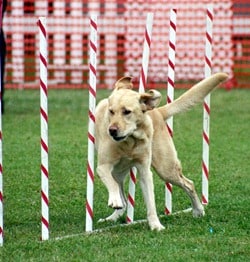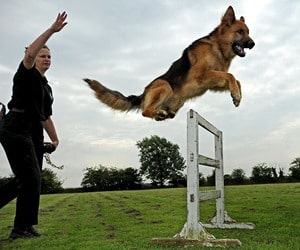Scooter doesn’t have to be a Obedience Champion to compete, but there are three control commands that he does have master: Come, Sit-Stay, and Down-Stay. As with all dog training, you need to make learning this fun, not work. Bear in mind that praise, clicks and treats will always win out over scolding and other forms of negative reinforcement. Incorporate these behaviors into your daily life – have Scooter Sit-Stay before eating his dinner, or Down-Stay before a rousing game of catch. Whatever you do, don’t use Come only when all the fun is over and it’s time to go home!
Teach Him To Change Direction – Somehow

Trainers who don’t use Left and Right choose not to because they know that it is difficult, if not impossible, to instantly issue the proper directional from the dog’s point of view. Scooter will be moving fast and turning often, and not everyone can shift perspective that easily. Instead, they use combinations of other directional commands such as Out, Here and Away. The Out! command doesn’t tell Scooter to leave the ring but to go away from you – no matter which side he is on. Here! is the opposite command, used when you want him to run toward you. And Away! tells him to run straight away from you toward whatever direction you are facing.
Play Follow the Leader
Scooter needs to learn to follow your movements. The easiest way to teach this is, of course, to make it fun. Go to a safe, preferably closed-in area so you don’t have to keep Scooter on a leash (if you do need the leash, attach it to yourself to leave your hands free. Walk around as though you were negotiating a maze, with frequent turns. When Scooter catches up, reward him (praise, click, or treat). Don’t get him to follow by calling or whistling for him: you want him to learn to read your body language. Don’t tire him out. Stop before he seems ready to stop since if he gets bored he won’t see it as a game but as work.
Don’t Name an Obstacle Too Soon

Be Kind to Animals
Learning means making “mistakes.” Scooter might knock off a rail, or head to the wrong obstacle, or any one of a number of other things can happen. Do not make a big deal of this. No scolding, reprimanding or even using a tone of voice that sounds as though he has done something wrong – he hasn’t. (Let’s see you run the course perfectly every time!) No matter what, praise him: for example, if you have to go back and reset the bar on a jump, make sure you say Good Dog! while you do it so he knows he didn’t do something bad. And don’t correct him with the word No. Always save No for only those times when danger is involved – when what Scooter is up to is something he absolutely should not be doing.
Dress Sensibly
It’s true that you are on display right there along with Scooter. But you will also be running, stopping, turning and just generally working up a sweat, so choose your “outfit” with care: running shoes or something similar that will let you negotiate the course, loose (but not too loose!) clothing that will let you move but won’t get caught on anything, and clothes appropriate for the temperature. This is not the time to show off the long wool dress and fancy heels you just found on sale. Your role is to help Scooter run the course, and he can’t do that if you’ve broken your ankle back at the first obstacle.
